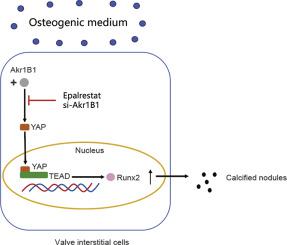Journal of Molecular and Cellular Cardiology ( IF 4.9 ) Pub Date : 2020-10-09 , DOI: 10.1016/j.yjmcc.2020.10.002 Chenyang Gao 1 , Wangxing Hu 1 , Feng Liu 1 , Zhiru Zeng 1 , Qifeng Zhu 1 , Jiaqi Fan 1 , Jinyong Chen 1 , Si Cheng 1 , Kaixiang Yu 1 , Yi Qian 1 , Tanchen Ren 1 , Jing Zhao 1 , Xianbao Liu 1 , Jian'an Wang 1

|
Aims
Calcific aortic valve disease (CAVD) is a primary cause of cardiovascular mortality; however, its mechanisms are unknown. Currently, no effective pharmacotherapy is available for CAVD. Aldo-keto reductase family 1 member B (Akr1B1) has been identified as a potential therapeutic target for valve interstitial cell calcification. Herein, we hypothesized that inhibition of Akr1B1 can attenuate aortic valve calcification.
Methods and results
Normal and degenerative tricuspid calcific valves from human samples were analyzed by immunoblotting and immunohistochemistry. The results showed significant upregulation of Akr1B1 in CAVD leaflets. Akr1B1 inhibition attenuated calcification of aortic valve interstitial cells in osteogenic medium. In contrast, overexpression of Akr1B1 aggravated calcification in osteogenic medium. Mechanistically, using RNA sequencing (RNAseq), we revealed that Hippo-YAP signaling functions downstream of Akr1B1. Furthermore, we established that the protein level of the Hippo-YAP signaling effector active-YAP had a positive correlation with Akr1B1. Suppression of YAP reversed Akr1B1 overexpression-induced Runx2 upregulation. Moreover, YAP activated the Runx2 promoter through TEAD1 in a manner mediated by ChIP and luciferase reporter systems. Animal experiments showed that the Akr1B1 inhibitor epalrestat attenuated aortic valve calcification induced by a Western diet in LDLR−/− mice.
Conclusion
This study demonstrates that inhibition of Akr1B1 can attenuate the degree of calcification both in vitro and in vivo. The Akr1B1 inhibitor epalrestat may be a potential treatment option for CAVD.
中文翻译:

醛酮还原酶家族 1 成员 B 通过激活瓣膜间质细胞中的河马信号诱导主动脉瓣钙化
宗旨
钙化性主动脉瓣疾病 (CAVD) 是心血管死亡的主要原因;然而,其机制尚不清楚。目前,没有有效的药物疗法可用于 CAVD。醛酮还原酶家族 1 成员 B (Akr1B1) 已被确定为瓣膜间质细胞钙化的潜在治疗靶点。在此,我们假设抑制 Akr1B1 可以减轻主动脉瓣钙化。
方法和结果
通过免疫印迹和免疫组织化学分析来自人类样本的正常和退行性三尖瓣钙化瓣膜。结果显示 CAVD 传单中 Akr1B1 的显着上调。Akr1B1 抑制减弱了成骨介质中主动脉瓣间质细胞的钙化。相反,Akr1B1 的过表达会加剧成骨培养基中的钙化。从机制上讲,使用 RNA 测序 (RNAseq),我们揭示了 Hippo-YAP 信号在 Akr1B1 下游起作用。此外,我们确定 Hippo-YAP 信号效应器 active-YAP 的蛋白质水平与 Akr1B1 呈正相关。YAP 的抑制逆转了 Akr1B1 过表达诱导的 Runx2 上调。此外,YAP 以 ChIP 和荧光素酶报告系统介导的方式通过 TEAD1 激活 Runx2 启动子。-/-小鼠。
结论
这项研究表明,抑制 Akr1B1 可以减轻体外和体内的钙化程度。Akr1B1 抑制剂依帕司他可能是 CAVD 的潜在治疗选择。











































 京公网安备 11010802027423号
京公网安备 11010802027423号